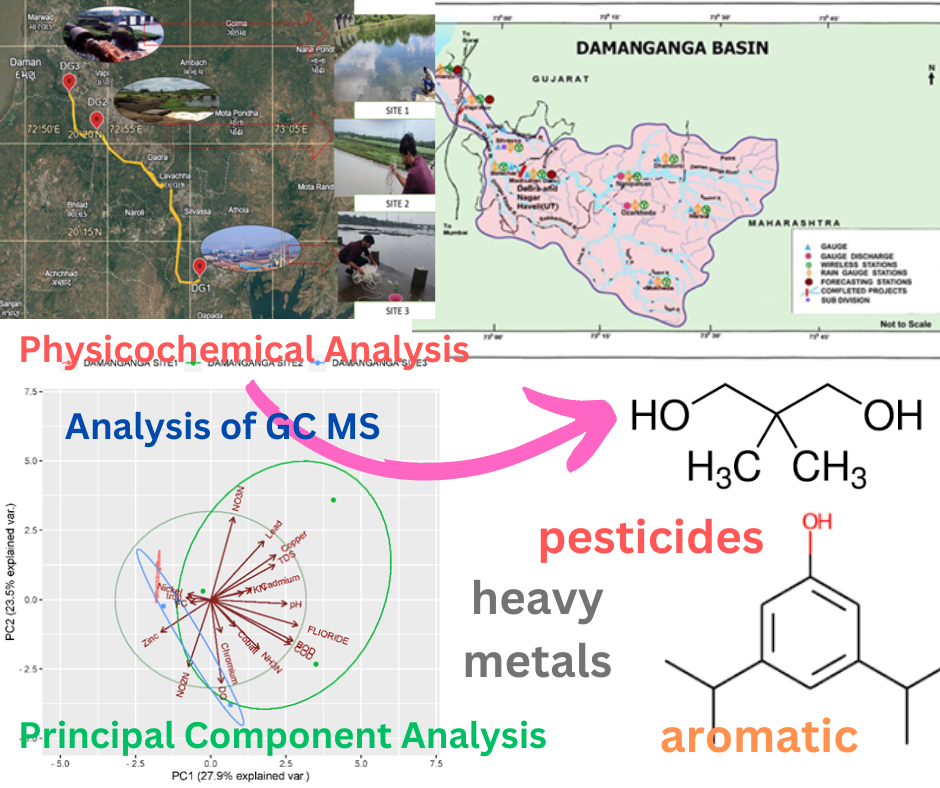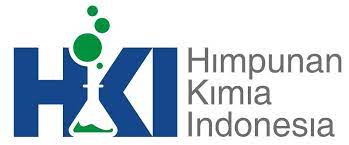
Assessment of the Ecological Impact of Pollution in the Damanganga River
Authors
Manoj Godhaniya , Komal Antaliya , Rajesh Patel , Charmy KothariDOI:
10.29303/aca.v7i1.201Published:
2024-04-19Issue:
Vol. 7 No. 1 (2024)Keywords:
Damanganga River, water pollution, ecological impact, physicochemical analysis, principal component analysisArticles
Downloads
How to Cite
Downloads
Metrics
Abstract
The Damanganga River faces severe pollution from industrial effluents and sewage, impacting its ecological health. The study aimed to analyze the current water quality status at the proposed conventional barrage site across the river between Silvassa, Vapi and Daman in India. Water samples were collected from three sites along the river during different seasons and analyzed for physicochemical parameters like TDS, COD, BOD, nutrients, fecal coliforms, heavy metals, etc. as per standard methods. Principal component analysis (PCA) was done. GCMS profiling of organics was also carried out. Several parameters exceeded the desired limits. TDS, BOD, fecal coliforms were very high indicating organic pollution and sewage contamination. Dissolved oxygen was deficient at some sites. Cadmium, copper and iron exceeded limits due to industrial releases containing these metals. PCA showed organic pollution as the major degrading factor for water quality followed by industrial contamination. GCMS analysis revealed hazardous organics like petrochemicals, fatty acids, solvents, pesticides and aromatic pollutants at varying levels along the river’s course demonstrating pollution from oil spillages, industrial effluents and agricultural runoff. The findings confirm severe deterioration in the Damanganga's water quality from inadequately treated sewage and industrial discharges posing environmental and health risks. Stringent regulations, proper wastewater treatment, runoff control and regular monitoring are vital to improve the river's condition
References
U.T. Administration of Daman & Diu, 2019, “http://daman.nic.in/websites/Pollution-Control-Committee/2019/Action-Plan-on-Damanganga-River-03-04-2019.pdf.” Accessed: Feb. 23, 2024. [Online]. Available: http://daman.nic.in/websites/Pollution-Control-Committee/2019/Action-Plan-on-Damanganga-River-03-04-2019.pdf
I. Alkorta, L. Epelde, and C. Garbisu, “Environmental parameters altered by climate change affect the activity of soil microorganisms involved in bioremediation,” FEMS Microbiology Letters, vol. 364, no. 19, pp. 1–9, 2017, doi: 10.1093/femsle/fnx200.
Z. U. Shah and S. Parveen, “Pesticides pollution and risk assessment of river Ganga: A review,” Heliyon, vol. 7, no. 8, p. e07726, Aug. 2021, doi: 10.1016/j.heliyon.2021.e07726.
R. Bhutiani, D. R. Khanna, B. Tyagi, P. Tyagi, and D. B. Kulkarni, “Assessing environmental contamination of River Ganga using correlation and multivariate analysis,” Polymer Journal, 2015, Accessed: Feb. 23, 2024. [Online]. Available: https://www.semanticscholar.org/paper/Assessing-environmental-contamination-of-River-and-Bhutiani-Khanna/08e53ec50daf50b768cf13b2e879b16f0ea22451
R. Tiwary and B. B. Dhar, “Environmental Pollution From Coal Mining Activities .In Damodar River Basin, India,” Jun. 1994. Accessed: Feb. 23, 2024. [Online]. Available: https://www.semanticscholar.org/paper/Environmental-Pollution-From-Coal-Mining-Activities-Tiwary-Dhar/452ad5b4a9844ed10001bc76add064e80a62d5c1
P. Mondal et al., “Assessment of the impact of the different point sources of pollutants on the river water quality and the evaluation of bioaccumulation of heavy metals into the fish ecosystem thereof,” International Journal of Experimental Research and Review, vol. 27, pp. 32–38, Apr. 2022, doi: 10.52756/ijerr.2022.v27.003.
D. S. Malik, A. Bisht, and R. Chauhan, “Assessment of Pollution Load and Its Impact on Aquatic Biodiversity of River Ganga: A Review,” in Environmental Pollution and Natural Resource Management, K. D. Bahukhandi, N. Kamboj, and V. Kamboj, Eds., in Springer Proceedings in Earth and Environmental Sciences. Cham: Springer International Publishing, 2022, pp. 91–102. doi: 10.1007/978-3-031-05335-1_6.
M. M. Islam, O. K. Lenz, A. K. Azad, M. H. Ara, M. Rahman, and N. Hassan, “Assessment of Spatio-Temporal Variations in Water Quality of Shailmari River, Khulna (Bangladesh) Using Multivariate Statistical Techniques,” Journal of Geoscience and Environment Protection, vol. 5, no. 1, Art. no. 1, Jan. 2017, doi: 10.4236/gep.2017.51001.
G. Matta and D. P. Uniyal, “Assessment of species diversity and impact of pollution on limnological conditions of River Ganga,” IJW, vol. 11, no. 2, p. 87, 2017, doi: 10.1504/IJW.2017.083759.
“CPCB | Central Pollution Control Board.” Accessed: Feb. 23, 2024. [Online]. Available: https://cpcb.nic.in/annual-report.php
“APHA (2005) Standard Methods for the Examination of Water and Wastewater. 21st Edition, American Public Health Association/American Water Works Association/Water Environment Federation, Washington DC. - References - Scientific Research Publishing.” Accessed: Mar. 06, 2023. [Online]. Available: https://www.scirp.org/(S(czeh2tfqyw2orz553k1w0r45))/reference/ReferencesPapers.aspx?ReferenceID=1870039
M. Khan, T. Omer, A. Ellahi, Z. Ur Rahman, R. Niaz, and S. Ahmad Lone, “Monitoring and assessment of heavy metal contamination in surface water of selected rivers,” Geocarto International, vol. 38, no. 1, p. 2256313, Dec. 2023, doi: 10.1080/10106049.2023.2256313.
K. Khatoon and A. Malik, “Screening of polycyclic aromatic hydrocarbon degrading bacterial isolates from oil refinery wastewater and detection of conjugative plasmids in polycyclic aromatic hydrocarbon tolerant and multi-metal resistant bacteria,” Heliyon, vol. 5, no. 10, p. e02742, Oct. 2019, doi: 10.1016/j.heliyon.2019.e02742.
Z. Bang-hui, “Application of Principal Component Analysis in Evaluation of Water Quality of Lean River,” China Water & Wastewater, 2009, Accessed: Feb. 23, 2024. [Online]. Available: https://www.semanticscholar.org/paper/Application-of-Principal-Component-Analysis-in-of-Bang-hui/e5c9a9327fb411c4d295cd6c51487a9b43c1a630
S. D. A. Daflon, I. L. Guerra, M. V. Reynier, A. C. Cerqueira, C. R. Botta, and J. C. Campos, “Toxicity identification and evaluation (TIE) of a petroleum refinery wastewater,” Journal of Environmental Science and Health, Part A, pp. 1–7, Apr. 2017, doi: 10.1080/10934529.2017.1312186.
M. Glendell, R. Sinha, B. Choudhary, M. Singh, and S. Ray, “Probabilistic modelling of water quality in the Ramganga River, India, informed by sparce observational data,” Copernicus Meetings, EGU23-7990, Feb. 2023. doi: 10.5194/egusphere-egu23-7990.
L. Dsikowitzky, O. Botalova, S. Illgut, S. Bosowski, and J. Schwarzbauer, “Identification of characteristic organic contaminants in wastewaters from modern paper production sites and subsequent tracing in a river,” Journal of Hazardous Materials, vol. 300, pp. 254–262, Dec. 2015, doi: 10.1016/j.jhazmat.2015.07.001.
S. Santy, P. Mujumdar, and G. Bala, “Increased risk of water quality deterioration under climate change in Ganga River,” Frontiers in Water, vol. 4, 2022, Accessed: Feb. 23, 2024. [Online]. Available: https://www.frontiersin.org/journals/water/articles/10.3389/frwa.2022.971623.
License
Copyright (c) 2024 Manoj Godhaniya, Komal Antaliya, Rajesh Patel, Charmy Kothari

This work is licensed under a Creative Commons Attribution-NonCommercial-ShareAlike 4.0 International License.
Authors who publish with ACA: Acta Chimica Asiana agree to the following terms:
- Authors retain copyright and grant the journal right of first publication with the work simultaneously licensed under a Creative Commons Attribution-NonCommercial-ShareAlike 4.0 International License. This license allows authors to use all articles, data sets, graphics, and appendices in data mining applications, search engines, web sites, blogs, and other platforms by providing an appropriate reference. The journal allows the author(s) to hold the copyright without restrictions and will retain publishing rights without restrictions.
- Authors are able to enter into separate, additional contractual arrangements for the non-exclusive distribution of the journal's published version of the work (e.g., post it to an institutional repository or publish it in a book), with an acknowledgement of its initial publication in ACA: Acta Chimica Asiana.
- Authors are permitted and encouraged to post their work online (e.g., in institutional repositories or on their website) prior to and during the submission process, as it can lead to productive exchanges, as well as earlier and greater citation of published work (See The Effect of Open Access).





 Indonesian Chemical Society, Chapter Nusa Tenggara. Jalan Majapahit 62 Mataram, University of Mataram, 83125, Indonesia
Indonesian Chemical Society, Chapter Nusa Tenggara. Jalan Majapahit 62 Mataram, University of Mataram, 83125, Indonesia





